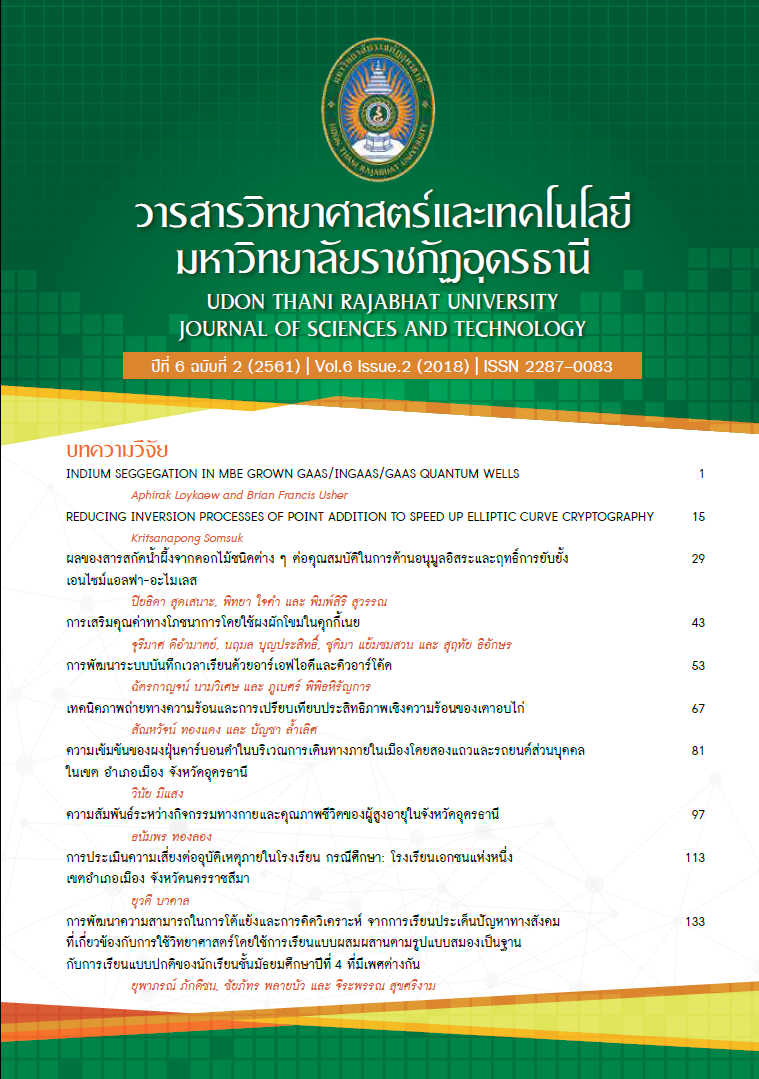ผลของสารสกัดน้ำผึ้งจากดอกไม้ชนิดต่าง ๆ ต่อคุณสมบัติในการต้านอนุมูลอิสระ และฤทธิ์การยับยั้งเอนไซม์แอลฟา-อะไมเลส
Main Article Content
บทคัดย่อ
งานวิจัยนี้มีวัตถุประสงค์เพื่อวิเคราะห์หาปริมาณสารสำคัญบางชนิด (กรดแอสคอร์บิค และ/หรือสารประกอบพอลีฟีนอล) และกิจกรรมในการต้านอนุมูลอิสระ (วิธี DPPH, FRAP และ ABTS+) ในน้ำผึ้ง และสารสกัดน้ำผึ้งดอกลำไย ดอกลิ้นจี่ และดอกไม้ป่า นอกจากนั้นยังได้ศึกษาฤทธิ์การยับยั้งเอนไซม์แอลฟา-อะไมเลสอีกด้วย โดยพบว่า น้ำผึ้งดอกลำไยมีปริมาณกรดแอสคอร์บิก สารประกอบพอลีฟีนอลลิกทั้งหมด และค่า DPPH inhibition มากกว่าน้ำผึ้งดอกลิ้นจี่ และน้ำผึ้งดอกไม้ป่าอย่างมีนัยสำคัญทางสถิติ แต่อย่างไรก็ตามพบว่า ตัวอย่างน้ำผึ้งทั้งสามชนิดมีปริมาณสารประกอบฟลาโวนอยด์ ค่า FRAP และฤทธิ์การยับยั้ง ABTS+ ที่ไม่แตกต่างกัน โดยปริมาณสารสำคัญ และประสิทธิภาพในการต้านอนุมูลอิสระของสารสกัดจากน้ำผึ้งทั้งสามชนิดที่ตรวจพบมีระดับที่สอดคล้องกับน้ำผึ้งตัวอย่าง สารสกัดจากน้ำผึ้งดอกลำไย และน้ำผึ้งดอกไม้ป่ามีประสิทธิภาพในการยับยั้งเอนไซม์แอลฟา-อะไมเลสไม่แตกต่างกัน และมีค่ามากกว่าสารสกัดจากน้ำผึ้งดอกลิ้นจี่อย่างเห็นได้ชัด ดังนั้นสรุปได้ว่าสารประกอบพอลีฟีนอลที่สกัดได้จากน้ำผึ้ง โดยเฉพาะอย่างยิ่งในน้ำผึ้งดอกลำไยและน้ำผึ้งดอกไม้ป่ามีคุณสมบัติเป็นสารต้านอนุมูลอิสระ และสามารถยับยั้งการทำงานของเอนไซม์แอลฟา-อะไมเลสได้
Article Details
References
สำนักงานมาตรฐานสินค้าเกษตรและอาหารแห่งชาติ. (2556). มาตรฐานสินค้าเกษตร (มกษ. 8003-2556) “น้ำผึ้ง”. กระทรวงเกษตรและสหกรณ์ กรุงเทพมหานคร.
สุมิตร คุณเจตน์, นิสาชล เทศศรี, ทัตพล พุ่มดารา และ สหัชชา สุทธิผล. (2560). ผลของการลดความชื้นต่อการคงคุณภาพของน้ำผึ้งชันโรง. แก่นเกษตร, 45(ฉบับพิเศษ 1), 1355-1359.
Biluca, F. C., de Gois, J. S., Schulz, M., Braghini, F., Gonzaga, L. V., Maltez, H. F., Rodrigues, E., Vitali, L., Micke, G. A., Borges, D. L. G., Costa, A. C. O., & Fett, R. (2017). Phenolic Compounds, Antioxidant Capacity and Bioaccessibility of Minerals of Stingless Bee Honey (Meliponinae). Journal of Food Composition and Analysis, 63, 89–97.
Bogdanov, S., Jurendic, T., Sieber, R., & Gallmann, P. (2008). Honey for Nutrition and Health: A Review. Journal of the American College of Nutrition, 27(6), 667–689.
Chaikham, P., Kemsawasd, V., & Apichartsrangkoon, A. (2016). Effects of Conventional and Ultrasound Treatments on Physicochemical Properties and Antioxidant Capacity of Floral Honeys from Northern Thailand. Food Bioscience, 15, 19–26.
Chua, L. S., Rahaman, N. L. A., Adnan, N. A., & Tan, T. T. E. (2013). Antioxidant Activity of Three Honey Samples in Relation with Their Biochemical Components. Journal of Analytical Methods in Chemistry, https://doi.org/ 10.1155/2013/313798.
Deng, J., Liu, R., Lu, Q., Hao, P., Xu, A., Zhang, J., & Tan, J. (2018). Biochemical Properties, Antibacterial and Cellular Antioxidant Activities of Buckwheat Honey in Comparison to Manuka Honey. Food Chemistry, 252, 243–249.
Devarajan, S., & Venugopal, S. (2012). Antioxidant and α-Amylase Inhibition Activities of Phenolic Compounds in the Extracts of Indian Honey. Chinese Journal of Natural Medicines, 10(4), 255–259.
do Nascimento, K. S., Sattler, J. A. G., Macedo, L. F. L., González, C. V. S., de Melo, I. L. P., da Silva Araújo, E., Granato, D., Sattler, A., & de Almeida-Muradian, L. B. (2018). Phenolic Compounds, Antioxidant Capacity and Physicochemical Properties of Brazilian Apis mellifera Honeys. LWT-Food Science and Technology, 91, 85–94.
Gheldof, N., Wang, X. H., & Engeseth, N. H. (2002). Identification and Quantification of Antioxidant Components of Honeys from Various Floral Sources. Journal of Agricultural and Food Chemistry, 50(21), 5870–5877.
Gül, A., & Pehlivan, T. (2018). Antioxidant Activities of Some Monofloral Honey Types Produced Across Turkey. Saudi Journal of Biological Sciences, https://doi.org/10.1016/j.sjbs.2018.02.011.
Kanjiro, T., & Yuji, M. (2006). Inhibition of α-Glucosidase and α-Amylase by Flavonoids. Journal of Nutritional Science and Vitaminology, 52, 149–153.
Khan, S. U., Anjum, S. I., Rahman, K., Ansari, M. J., Khan, W. U., Kamal, S., Khattak, B., Muhammad, A., & Khan, H. U. (2018). Honey: Single Food Stuff Comprises Many Drugs. Saudi Journal of Biological Sciences, 25, 320–325.
Kowalski, S., (2013). Changes of Antioxidant Activity and Formation of 5-Hydroxymethylfurfural in Honey during Thermal and Microwave Processing. Food Chemistry, 141, 1378–1382.
Ramos, O. Y., Salomon, V., Libonatti, C., Cepeda, R., Maldonado, L., & Basualdo, M. (2018). Effect of Botanical and Physicochemical Composition of Argentinean Honeys on the Inhibitory Action Against Food Pathogens. LWT-Food Science and Technology, 87, 457–463.
Sangsrichan, S., & Wanson, W. (2008). The Antioxidant Capacity of Honey Samples Collected in the North Part of Thailand in Relationship with Its Total Polyphenol. KMITL Science Journal, 8, 1–6.
Suthindhiran, K. R., Jayasri, M. A., & Krishnan, K. (2009). α-Glucosidase and α-Amylase Inhibitory Activity of Micromonospora sp. VITSDK3 (EU551238). International Journal of Integrative Biology, 6(3), 115–120.
Tuksitha, L., Chen, Y. L. S., Chen, Y. L., Wong, K. Y., & Peng, C. C. (2018). Antioxidant and Antibacterial Capacity of Stingless Bee Honey from Borneo (Sarawak). Journal of Asia-Pacific Entomology, 21, 563–570.

